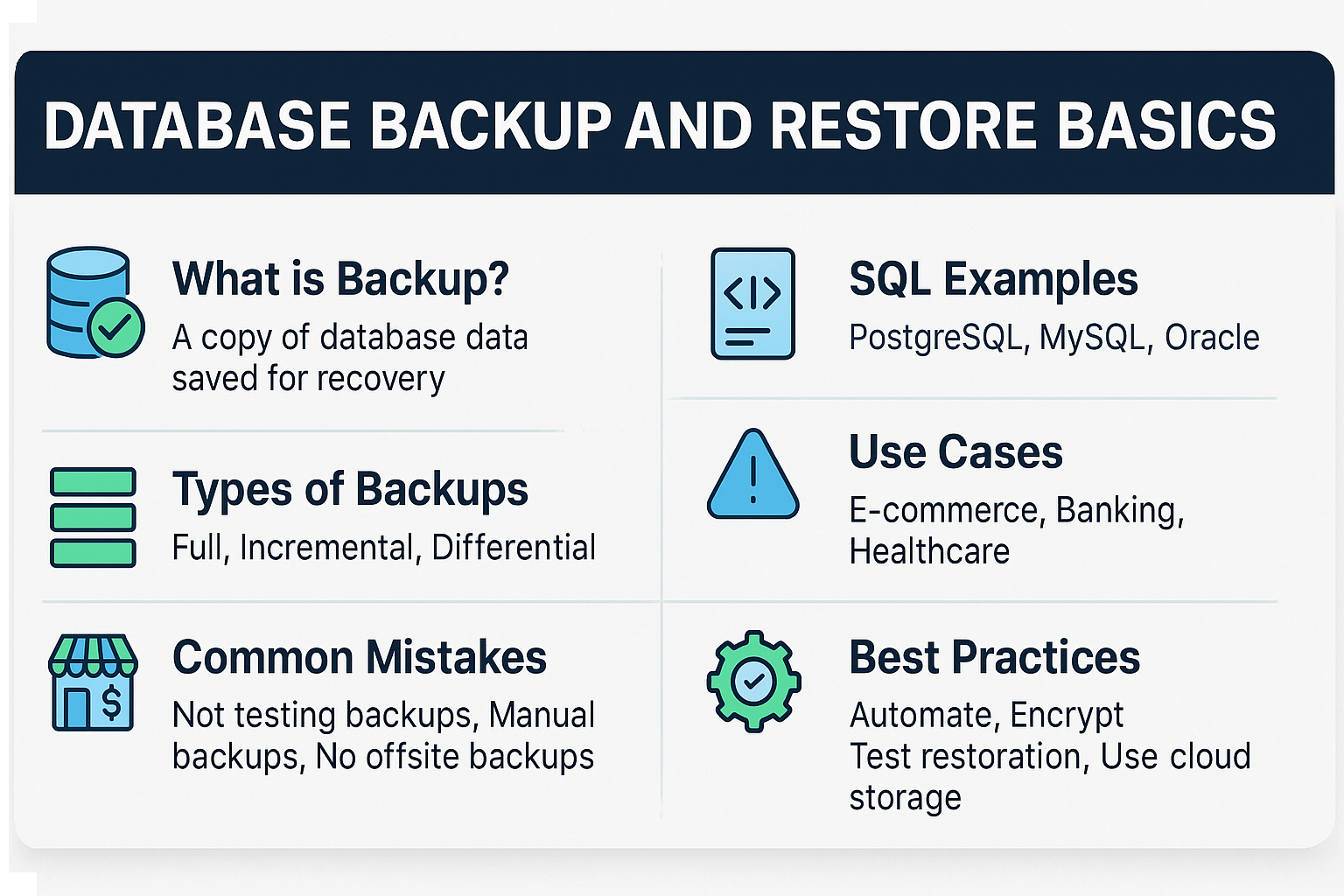Introduction
Database backup and restore are critical processes to safeguard data against corruption, hardware failures, or accidental deletion. A good backup and recovery strategy ensures business continuity and data integrity.
Why Backup and Restore Matter
- Protects against data loss from failures or human error.
- Ensures compliance with legal and business requirements.
- Enables disaster recovery and minimal downtime.
Real-world analogy:
Backing up a database is like saving a copy of an important document to the cloud. If your local version is lost, you can restore it from the backup.
Core Concepts
What is a Database Backup?
- A copy of database data and metadata saved for recovery.
- Can be full, incremental, or differential.
What is Restore?
- The process of loading backup data into a database to recover to a previous state.
Types of Backups
- Full Backup: Complete database snapshot.
- Incremental Backup: Only changes since the last backup.
- Differential Backup: Changes since the last full backup.
SQL Examples
PostgreSQL Backup and Restore
Backup:
pg_dump -U username -F c dbname > backup_file.dump
Restore:
pg_restore -U username -d dbname backup_file.dump
MySQL Backup and Restore
Backup:
mysqldump -u username -p dbname > backup_file.sql
Restore:
mysql -u username -p dbname < backup_file.sql
Oracle Backup and Restore (Using RMAN)
Backup:
RMAN> BACKUP DATABASE;
Restore:
RMAN> RESTORE DATABASE;
Real-World Use Cases
- E-commerce: Recovering customer and order data after hardware failure.
- Banking: Restoring transactions to ensure financial accuracy.
- Healthcare: Maintaining compliance with patient data regulations.
Common Mistakes and Anti-Patterns
- Not testing backups: Leads to unusable backups during emergencies.
- Relying on manual backups: Prone to human error.
- No offsite backups: Risky in case of physical disasters.
Performance and Scalability Implications
- Frequent backups can impact database performance; schedule during off-peak hours.
- Incremental backups reduce storage and time compared to full backups.
- Restoring large databases requires optimized storage and infrastructure.
RDBMS Comparison
| Feature | PostgreSQL | MySQL | Oracle |
|---|---|---|---|
| Logical Backup | pg_dump | mysqldump | Data Pump |
| Physical Backup | File-based | File-based | RMAN |
| Incremental Backup | Supported (tools) | Supported (tools) | Fully supported |
Best Practices & Optimization Tips
- Automate backups with cron jobs or scheduling tools.
- Store backups securely with encryption.
- Keep multiple backup versions for different restore points.
- Regularly test backup restoration to ensure integrity.
- Use cloud storage or offsite locations for disaster recovery.
When to Use vs When to Avoid
Use Backups When:
- Running any production database.
- Handling critical or sensitive data.
Avoid Skipping Backups When:
- Systems are mission-critical or regulated.
Conclusion & Key Takeaways
Database backup and restore are foundational for data protection. With proper strategies and testing, you can ensure reliable recovery and business continuity.
Key Points:
- Use full, incremental, or differential backups based on needs.
- Automate and test backups regularly.
- Store backups securely and offsite for disaster recovery.
FAQ
1. What is the difference between full and incremental backups?
Full backs up everything; incremental backs up only changes since the last backup.
2. How often should I back up my database?
Depends on data criticality; common intervals are daily full backups with hourly incrementals.
3. Can I restore a backup to a different server?
Yes, as long as the database version is compatible.
4. What is the fastest backup method?
Physical backups are faster but larger; logical backups are portable but slower.
5. How do I test backups?
Perform periodic restores to a staging server.
6. What’s the difference between pg_dump and pg_basebackup?
pg_dump is logical backup; pg_basebackup is a physical backup tool.
7. Does MySQL support incremental backups?
Yes, with binary logs or third-party tools like Percona XtraBackup.
8. Are backups encrypted by default?
No, encryption must be configured manually or via tools.
9. Can I back up a running database?
Yes, with tools supporting hot backups (e.g., Oracle RMAN).
10. Should I store backups in the same server?
No, use offsite or cloud storage for safety.
